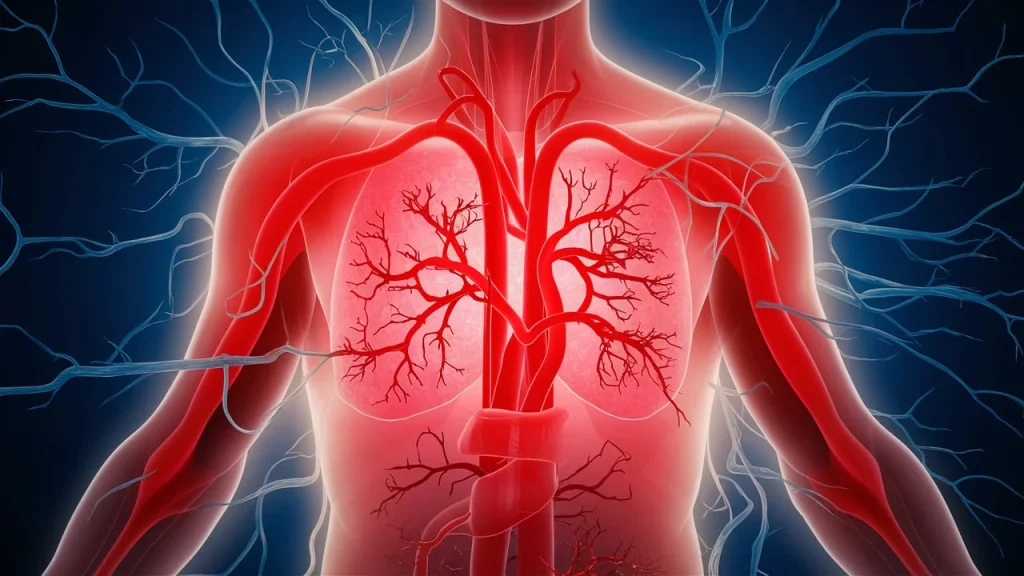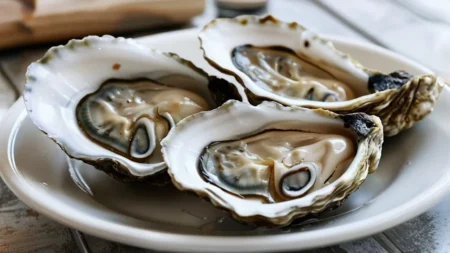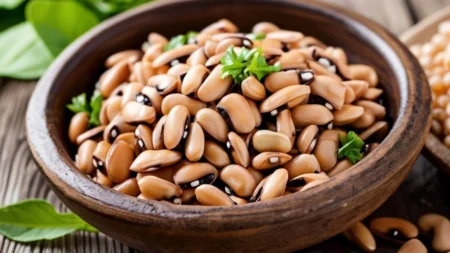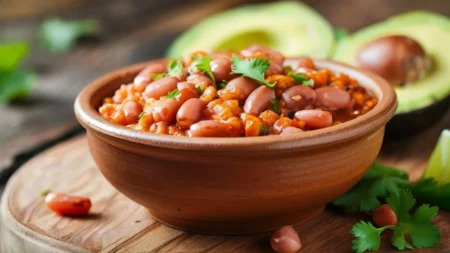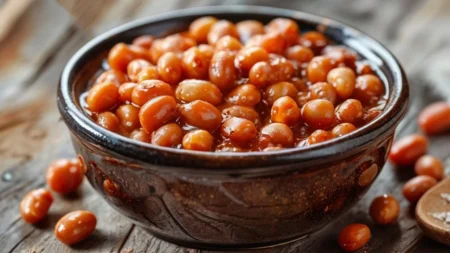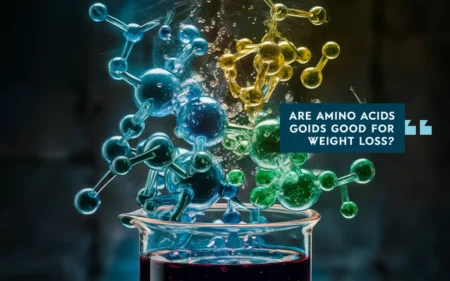Adipose tissue is key for energy balance and overall health. It takes part in making sure our body runs smoothly. Recent research shows how important it is for blood vessels and nerves to grow in this tissue, especially when obesity starts1. This tissue doesn’t just stay the same. It changes actively, using many pathways. This includes making new blood vessels, some scaring setting in, and making small spaces where immune cells gather1.
What’s really interesting is how the body reacts to cold or exercise. These things make the nerves in the adipose tissue work harder. This makes more blood vessels grow there1. Such changes affect the whole body’s metabolism, like how well you respond to insulin. This response is very important for people with type 2 diabetes1.
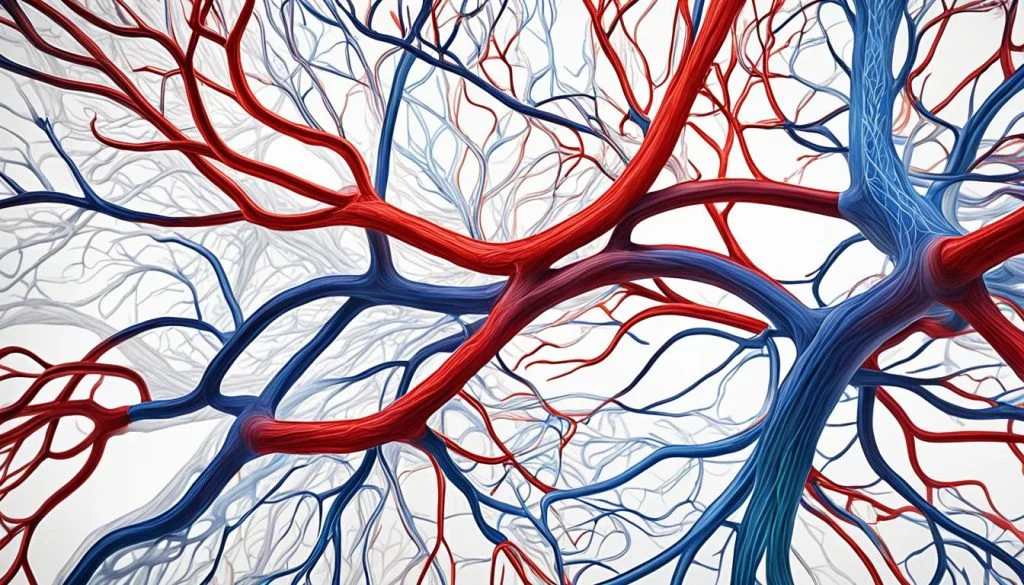
Key Takeaways
- Adipose tissue is a dynamic and metabolically active organ that undergoes remodeling processes, including angiogenesis and sympathetic innervation.
- Physical stimuli, such as cold exposure and exercise, can trigger sympathetic activation, leading to new blood vessel formation in adipose tissues.
- Adipose tissue remodeling processes are closely linked to systemic metabolic outcomes, including insulin sensitivity and type 2 diabetes.
- Understanding the role of blood vessels in white and brown adipose tissues is crucial for developing targeted therapies for obesity and metabolic diseases.
- Adipose tissue angiogenesis has emerged as a promising therapeutic target for addressing obesity and associated metabolic disorders.
Introduction to Adipose Tissue Vasculature
Adipose tissue has white and brown fat. It helps control metabolism and balance energy2. Obesity is a big problem worldwide, affecting our heart and metabolism. It shows why we need to know about the blood flow in fat2. Making new blood vessels through angiogenesis is crucial for fat to change. This way, it gets oxygen, nutrients, and other things it needs2.
Role of Angiogenesis in Adipose Tissue Remodeling
Angiogenesis supports fat tissue growth and change2. Obesity is bad for health and shortens life. So, we need to understand how fat changes2. New studies show nerves in fat are very important, more than we thought3. Figuring out how nerves reach fat is key to learning about these tissues3.
Fat has a lot of blood vessels for its needs. These vessels must be managed well to stay balanced and react to the body’s changes2. Making new vessels through angiogenesis is important for fat’s growth and change2. Learning how this process works can lead to new ways to fight obesity and its health problems2.
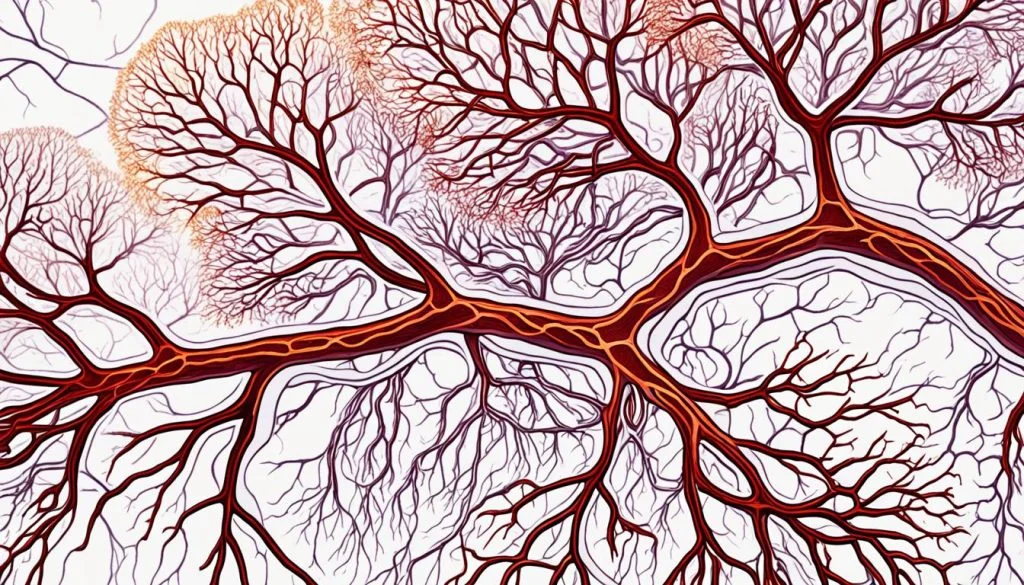
To sum up, we’ve seen how important blood vessel growth and nerve control are for fat tissue23. Knowing more about these can help create new ways to fight obesity around the world. It can also improve health by reducing the bad effects of obesity23.
blood vessels in white and brown adipose tissues
The method we’re talking about makes it easier to see blood vessels and nerve fibers better. It’s less complicated but more effective. Because it shows things in more detail, it’s easier to measure the size of vessels and how they branch out. This is done using free software4.
This new way helped scientists see that brown fat has more blood vessels and nerves than white fat. Brown fat is known for producing heat without shivering, which uses a lot of energy. In people, up to 15% of energy use comes from brown fat during this. Also, making more blood vessels in brown fat can help stop obese mice from gaining weight. It does this by making their fat work more like brown fat4.
The reason we can tell the difference between brown and white fat in pictures is because brown fat is denser. It’s denser than white fat but not as much as muscle. This higher density is because brown fat has more blood vessels4.
Additionally, a gold-based dye that stays in the blood longer is better for looking at blood flow in fat. This gold dye works better than the usual iodine dye. It’s good for studying how blood vessels change in brown and white fat over time4.
Thanks to these new ways of looking at things, we’re learning more about how blood vessels in fat differ. These differences help us understand how fat tissue affects our body’s energy use and health4.
“Brown adipose tissue is especially abundant in newborns and in hibernating mammals, and its prevalence decreases as humans age.”5
Brown fat is seen in many animals but is more in newborns and those that hibernate. As we get older, we have less of it. However, some studies show that even adults have active brown fat. When it’s working, it can help manage sugar and make the body respond better to insulin5.
So, all this new insight into the blood vessels of different fat types helps in studying how fat affects our metabolism and health. It gives us clues on how our body manages energy45.
Visualization and Quantification Techniques
A new way to stain blood vessels and nerve fibers in body fat has been found by researchers6. This method is easier and marks the vessels and fibers better than others6. It also gives clearer images for measuring vessel size, branching, and fiber length with free tools6.
Optimized Immunofluorescent Approach
There’s a better way to look at how body fat changes6. They look at fat’s nerves using thin slices and a special stain on slides6. The fat is mostly connected to certain nerves, so this is important6. Imaging these nerves needs special steps like removing fat and making it clear, just like when looking at the brain6.
Looking at whole fat areas aims to show all nerve pathways, dealing with issues like too much light and self-glow6. The usual way with thin slices makes it hard to fully see the nerves6.
FAQ
What is the critical role of angiogenesis and sympathetic innervation in adipose tissue remodeling during obesity development?
Recent studies point out how angiogenesis and sympathetic innervation are vital in changing adipose tissue during obesity’s growth. Adipose tissue does a lot in the body and changes size as our diet changes. It goes through a lot of changes like new blood vessels forming, making scar-like tissue, and changing the local areas where the immune system works. Things like being in the cold or exercising can get the body’s nerves excited, which helps in making more blood vessels and putting nerves everywhere. All these changes are very important for how our body deals with sugar, a key point in diabetes.
What is the importance of angiogenesis in adipose tissue remodeling?
Angiogenesis is key because it makes new blood vessels. Blood vessels bring oxygen, food, and useful chemicals to places like adipose tissue. That’s why making new blood vessels is important for changing this tissue’s size and function.
Why has sympathetic innervation in adipose tissue been underestimated for a long time?
For a while, people didn’t realize how important nerves are in adipose tissue, especially compared to blood vessels. However, lately, experts have seen that nerves play a big role too. They help control how adipose tissue works.
What are the advantages of the modified immunofluorescent approach described in the study?
This new way of looking at tissue with a microscope is better and easier than older methods. It shows blood vessels and nerves more clearly, without too much other stuff getting in the way. The pictures it takes help measure the size of blood vessels and how nerves are spread using specific software.
What did the researchers find about the differences in blood vessels and nerve fibers between brown adipose tissue (BAT) and white adipose tissue (WAT)?
When they used this new approach, the researchers found that BAT has more blood vessels and nerves than WAT. In the WAT type, the layer under the skin has more than the type around the belly. This shows how different types of fat might work in the body.
Source Links
- https://link.springer.com/chapter/10.1007/978-1-4614-8069-3_5 – Blood Vessels in White and Brown Adipose Tissues
- https://www.ncbi.nlm.nih.gov/pmc/articles/PMC7969519/ – The Interplay Between Adipose Tissue and Vasculature: Role of Oxidative Stress in Obesity
- https://www.ncbi.nlm.nih.gov/pmc/articles/PMC5059561/ – Differential Role of Adipose Tissues in Obesity and Related Metabolic and Vascular Complications
- https://www.nature.com/articles/s41598-022-25819-6 – In vivo imaging of brown adipose tissue vasculature reactivity during adrenergic stimulation of non-shivering thermogenesis in mice – Scientific Reports
- https://en.wikipedia.org/wiki/Brown_adipose_tissue – Brown adipose tissue
- https://www.ncbi.nlm.nih.gov/pmc/articles/PMC8479257/ – Visualization and analysis of whole depot adipose tissue neural innervation





